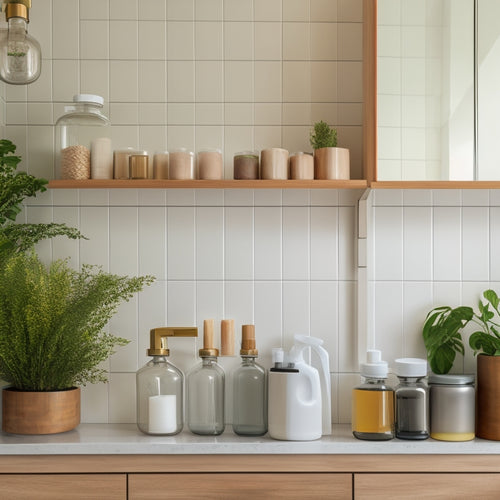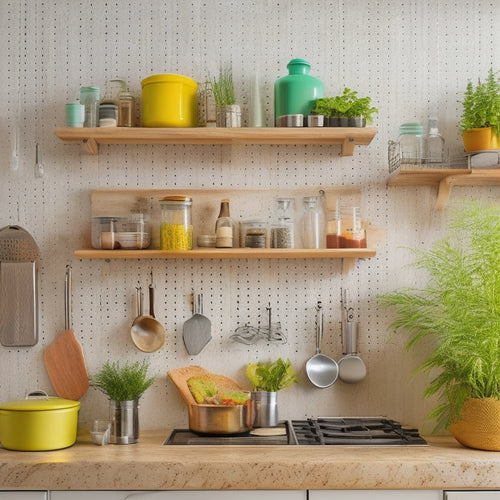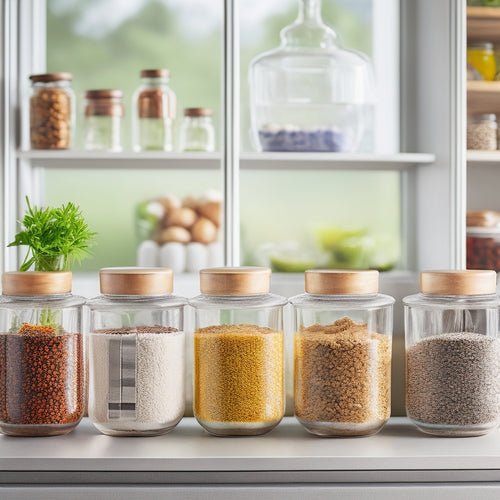
What's Behind Your Kitchen Cabinet Doors?
Share
Behind your kitchen cabinet doors lies a hidden world of storage potential, where cluttered shelves, expired spices, and disorganized kitchen essentials are waiting to be transformed. The chaos you're trying to hide is holding you back from a seamless cooking experience. Your cabinet doors are an untapped resource, ready to be optimized for efficiency, accessibility, and culinary joy. Imagine effortlessly finding the perfect blend of spices, and cooking up a storm in a stress-free kitchen. As you open those doors, a world of customizable storage solutions, removable storage options, and smart functionality awaits – and it's just the beginning of your kitchen transformation.
Key Takeaways
• Behind your kitchen cabinet doors lies a world of organization possibilities, waiting to be maximized for a seamless cooking experience.
• A well-organized cabinet reduces stress and saves time by providing easy access to essential items, enhancing kitchen workflow and mealtime delight.
• Customizable storage solutions, such as hooks, bins, and racks, can transform cabinet doors into functional storage space, catering to unique needs and preferences.
• By utilizing vertical space, door-mounted storage, and tiered shelves, you can optimize cabinet storage for efficiency and accessibility, making the most of your kitchen's real estate.
• With removable storage solutions, you can flexibly adjust shelves to accommodate items of varying sizes, eliminating the limitations of fixed shelves and creating a tailored storage system.
Hidden Storage Potential Revealed
As you swing open your kitchen cabinet doors, a vast, untapped storage territory stretches out before you, awaiting transformation into a haven of organized calm. It's time to tap into the hidden storage potential that's been hiding in plain sight.
Cabinet Psychology comes into play here, as the way you organize your cabinets can greatly impact your cooking experience and overall kitchen workflow. By applying Storage Secrets, you can maximize every inch of space, making meal prep a breeze.
Imagine being able to find what you need at a glance, with everything neatly categorized and easily accessible. It's not just about aesthetics; a well-organized cabinet can reduce stress and save you time.
Envision your kitchen as a serene and efficient hub, where you can focus on creating delicious meals for yourself and others. By revealing the secrets of your cabinet storage, you'll be able to serve others with confidence and ease, making mealtime a true delight.
Decluttering Your Kitchen Cabinet
As you open your kitchen cabinet doors, you're met with a jumbled mess of containers, utensils, and gadgets.
It's time to take control and clear the clutter out, starting with a thorough purge of unwanted kitchen items that have accumulated over time.
Clear the Clutter Out
You're standing in front of your kitchen cabinet, staring at the mess that's accumulated over time, with expired spices, chipped dishes, and mysterious Tupperware containers cluttering the shelves and making it difficult to find what you need when you need it. It's overwhelming, and you're not sure where to start. But it's time to clear the clutter out and create a more organized, functional space.
The first step is to acknowledge your kitchen habits and how they contribute to the clutter mindset. Do you tend to keep everything 'just in case' or hold onto items out of sentimental value? Recognizing these patterns will help you approach decluttering with a clearer mindset.
Take everything out of your cabinets and sort items into categories. This will give you a visual of what you have and help you identify what's truly useful. As you begin to clear the clutter, remember that it's not about getting rid of everything, but about creating a space that serves you and your needs.
Purge Unwanted Kitchen Items
With a clearer understanding of your kitchen habits, it's time to tackle the unwanted items that have taken up residence in your cabinets, starting with those expired spices and rusty kitchen gadgets that have outlived their usefulness.
You're not alone if you're a self-proclaimed kitchen hoarder – many of us hold onto items 'just in case' or because they hold sentimental value. But it's time to let go and make room for the essentials.
Spring cleaning is the perfect opportunity to purge your kitchen cabinets of items that no longer serve a purpose. Here are a few items worth evaluating getting rid of:
-
Expired or spoiled food: Check expiration dates and toss anything that's no longer safe to eat.
-
Broken or damaged items: If it's beyond repair, it's time to let it go.
-
Duplicates or triplicates: You only need one of each item, so consider donating or recycling extras.
- Kitchen gadgets you've never used: Be honest with yourself – if you haven't used it in the past year, you probably won't miss it.
Organize Remaining Essentials
Now that the unwanted items are gone, it's time to assign a home to the remaining essentials, grouping similar items together like baking supplies, cooking utensils, and dinnerware to create a sense of harmony within your kitchen cabinet.
Imagine your cabinet as a well-oiled machine, where every item has its designated spot, making meal prep a breeze.
Create Essential Zones by categorizing items into specific areas, such as a baking station or a cooking hub. This will help you navigate your cabinet with ease, saving you time and energy.
To maximize storage, utilize vertical space by installing shelves or baskets, keeping frequently used items at eye level.
Implement Efficiency Hacks like a Lazy Susan for corner cabinets, allowing you to access items without straining or digging.
Label each zone and shelf, ensuring everyone in the household knows where to find what they need.
DIY Spice Rack Solution
As you stand in front of your kitchen cabinet, you're probably thinking about how to maximize the space and keep your spices within easy reach.
To create a DIY spice rack solution, you'll need to gather a few essentials, like wooden boards, hooks, and baskets.
Spice Rack Essentials Needed
You'll need a few essential components to create a functional and organized DIY spice rack solution that fits your kitchen style. To get started, gather the following must-haves:
-
Spice containers: Choose containers that are airtight, moisture-resistant, and easy to label. You can opt for glass jars, stainless steel containers, or even repurpose small mason jars.
-
Spice labels: Design and print labels that match your kitchen's aesthetic. You can use a label maker or create your own using cardstock and a printer.
-
Spice rack or board: Select a spice rack or board that fits your available cabinet space. You can opt for a wall-mounted rack, a magnetic board, or a freestanding rack.
- Spice pairing guide: Create a guide that lists your favorite spice pairings and flavor profiles. This will help you quickly find the perfect combination for your recipes.
With these essentials, you'll be well on your way to creating a DIY spice rack solution that streamlines your cooking process and enhances your culinary creations.
Imagine effortlessly finding the perfect blend of spices to elevate your dishes, from the warmth of cumin and coriander to the brightness of basil and oregano.
Optimize Cabinet Storage Space
With your DIY spice rack components in hand, it's time to turn your attention to the most critical aspect of this project: configuring your cabinet storage space to maximize efficiency and accessibility.
Take a step back and assess your cabinet's dimensions, considering the width, height, and depth of the space. Visualize how you'll use the area, thinking about the items you'll store and how often you'll need to access them.
Next, think about the storage systems that will work best for you. Will a tiered system with multiple shelves help you make the most of your cabinet's vertical space? Or will a slide-out drawer or basket system make it easier to retrieve items from the back of the cabinet?
Consider the types of items you'll be storing, such as spices, oils, or condiments, and choose a system that caters to their unique needs.
Maximizing Door Space Efficiency
Behind your kitchen cabinet doors lies a treasure trove of untapped storage potential, waiting to be accessed by cleverly maximizing door space efficiency. By doing so, you'll reveal a wealth of opportunities to declutter your kitchen and make meal prep a breeze.
One key strategy is to ponder the door swing: do your cabinet doors open to the left or right? This will impact how you utilize the space.
Here are some tips to get you started:
-
Shelf utilization: install shelves, baskets, or racks to store items like spices, oils, or cleaning supplies.
-
Door-mounted storage: use over-the-door hooks, bins, or racks to hang items like utensils, aprons, or dish towels.
-
Tiered storage: add multiple levels of storage to maximize vertical space and keep frequently used items within easy reach.
- Adjustable storage: invest in adjustable shelves or baskets to accommodate items of varying sizes.
Customizable Storage Options
Your kitchen cabinet doors become a canvas for customization when you incorporate adjustable, modular, or removable storage solutions that flex to fit your unique needs and preferences. As you open your cabinet doors, you're no longer limited by fixed shelves. Instead, you're greeted by a world of possibilities. With adjustable shelving, you can tailor the height and width of your shelves to accommodate items of varying sizes, from petite spice jars to bulky cookware.
Guarantee mechanisms that your cabinet doors shut smoothly and quietly, eliminating the jarring sound of slamming doors. This thoughtful design detail creates a seamless user experience, making it a joy to cook, store, and retrieve your kitchen essentials.
Organizing Kitchen Essentials
As you step into your kitchen, the contents of your cabinets come into focus, revealing a medley of jars, bottles, and cookware that cry out for a sense of order and organization. It's time to tame the chaos and create a kitchen that's both functional and stylish.
To achieve this, start by categorizing your kitchen essentials into groups, such as baking, cooking, and food storage.
Here are some kitchen hacks to get you started:
-
Assign a home: Designate a specific cabinet or shelf for each category, ensuring everything has a designated spot.
-
Use vertical space: Maximize your cabinet's vertical space by using stackable containers or shelves to store less frequently used items.
-
Label and sign: Label each category and sign the corresponding cabinet or shelf, making it easy for everyone to find what they need.
- Store heavy items below: Place heavy items, like pots and pans, on lower shelves to prevent them from falling and causing a mess.
Transforming Cabinet Door Functionality
With a few clever tweaks, your cabinet doors can evolve from mere barriers to functional hubs that streamline your kitchen workflow and add a touch of sophistication to your cooking space.
By incorporating smart hinges, you can create soft-close doors that eliminate the annoying slam, making your kitchen a more peaceful and enjoyable space for you and your loved ones.
Moreover, you can upgrade your cabinet facades to include built-in accessories like spice racks, utensil holders, or even a built-in coffee station. This won't only enhance the aesthetic appeal of your kitchen but also provide convenient access to frequently used items, saving you time and effort.
Imagine being able to whip up a meal while effortlessly accessing the ingredients and tools you need, all within arm's reach.
Frequently Asked Questions
Can I Install Cabinet Organizers Myself or Do I Need a Professional?
You can install cabinet organizers yourself, but be prepared to tackle DIY challenges like measuring, drilling, and assembling. Make sure you have the necessary tools, like a level and drill press, to get the job done efficiently and accurately.
How Often Should I Clean Behind My Kitchen Cabinet Doors?
"You're sweating the small stuff, but dust accumulation and hidden pests behind those kitchen cabinet doors won't disappear on their own. Clean them every 3-6 months to avoid unwanted critters and a dusty mess."
Are Adjustable Shelves Suitable for Corner Kitchen Cabinets?
When you're designing corner kitchen cabinets, adjustable shelves can be a game-changer, offering shelf flexibility to maximize storage despite corner constraints, and you'll love how they help you create a functional, clutter-free space that serves others beautifully.
Can I Repaint or Refinish My Existing Cabinet Doors?
"Like a blank canvas, your existing cabinet doors await transformation! You can repaint or refinish them, updating the cabinet hardware and paint finish to match your style, and create a warm, inviting space that serves up more than just meals."
Will Cabinet Door Organizers Fit My Non-Standard Sized Cabinets?
You'll need custom measurements to guarantee a perfect fit, so take a closer look at your cabinet anatomy, noting the unique dimensions and layout of your non-standard sized cabinets, to find the ideal organizers for your space.
Related Posts
-

Under-Sink Storage Tips for Minimalist Kitchens
To maximize under-sink storage in your minimalist kitchen, start by utilizing vertical space with shelf risers and st...
-

Stylish Pegboard Storage for Open Kitchen Concepts
Stylish pegboard storage can completely enhance your open kitchen concept, merging practicality with contemporary fla...
-

Stackable Kitchen Containers for Dry Goods
Stackable kitchen containers are perfect for organizing dry goods and maximizing your kitchen space. They help reduce...


